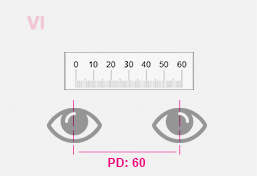


















Your Rx is what an ophthalmologist (an MD) or optometrist (a doctor of optometry) provides to correct your vision with a pair of eyeglasses with corrective lenses.
.jpg)
ADD(also NV-ADD):The Near Vision (NV) Reading ADDition correction on a multifocal Rx. Can be used for bifocal or progressive glasses, or for single-vision reading or computer (intermediate) vision glasses.

AR:Anti-Reflective. A coating that reduces reflection on the lenses.
AXIS:The angle at which the Cylinder (CYL) is placed on a lens to correct an astigmatism. It ranges from 1 to 180.
BAL:The Rx calls for balance lenses, meaning the same Rx for each eye. Often used when a person has no sight in one eye, so both lenses will have the same thickness.
BD, BI, BO, BU:A prism correction on your Rx (may be indicated with Δ, and one of these four abbreviations. The B stands for base, and it could be base down (BD), base in (BI), base out (BO), or base up (BU).
CYL:The Cylinder. Combined with the , the CYL corrects an astigmatism.
DS:The abbreviation for . An eye dr. may write DS on an Rx in the field if no astigmatism correction is needed.
DV:Distance vision.
FT:Flat-top bifocal.
NV:Near vision.
NV-ADD (also ADD):The Near Vision (NV) Reading ADDition correction on a multifocal Rx. Can be used for bifocal or progressive glasses, or for single-vision reading or computer (intermediate) vision glasses.
OD:Latin for Oculus Dexter, meaning the right eye.
OS:Latin for Oculus Sinister, meaning the left eye.
OU:Latin for Oculus Uterque, meaning each eye.
PAL:Progressive Addition (or Adjustment) Lens: sometimes on a Progressive Rx an eye dr. will write two different numbers for the NV-ADD, perhaps +2.25 and +2.50, to increase the reading power in the NV-ADD for Progressive lenses.
PD (Pupillary Distance):The PD is the measurement of the distance between your pupils. This is needed for the manufacturer of the eyeglasses to know where to place the optical center on each lens, so you can see well with the glasses.
PL:Plano. Latin for ""flat."" If this is in the SPH section of an Rx, it means no nearsighted or farsighted correction is needed.
RX:A prescription.
SPH:The first section on an Rx. It corrects nearsighted or farsighted vision.
UV:The abbreviation of ultraviolet. UV light is invisible to the human eye, but it is UV light that gives us a sunburn, and too much exposure to it can damage the eye. All of the lenses WhereLight offers come with 100 percent UV protection, for free.
VA:Visual acuity: how well the eye can see. Sometimes this may be written on an Rx, with a number such as 20/20. This would indicate that with eyeglasses made to this , the vision would be corrected to 20/20 vision.


Print this page on A4 without scaling, at 100%.
|

Fold Fold the ruler along the dotted line.
|

Mirror or Friend Position yourself arm's length from your friend or yourself approximately 8 inches (20cm) away from a mirror.
|

Close your left eye and align the 0mm over the center of your right pupil. Place ruler against forehead for stability.
|

Next, open your right eye and close your left eye.
|

Note the reading directly over your left pupil. That will be your PD. (Most adults have a PD that falls between 57 - 72mm)
|
Up to -20.00 or +12.00 on the Sphere (SPH)
Up to + or - 6.00 on the Cylinder (CYL).
Bifocal Rx:Up to -9.00 or +6.00 on the SPH.
Up to + or - 6.00 on the CYL.
Up to +3.50 on the NV-ADD.
Progressive Rx:Up to -10.00 or +8.00 on the SPH.
Up to + or - 6.00 on the CYL.
Up to +3.50 on the NV-ADD.
Prism (single-vision only):Up to 5.00 in any direction.
Yes! We offer both. If you have ADD or NV-ADD on your Rx, you can get lined bifocals or unlined progressive glasses.
If you have a glasses prescription with an NV-ADD, it is best to order Prescription Reading Glasses. If you do not have a glasses prescription and typically buy reading glasses from the drugstore, you may consider Over the Counter Reading Glasses.
Prescription Reading GlassesIt is easy to reconfigure an Rx with an NV-ADD. It just involves a little grade-school arithmetic.
You simply take the NV-ADD number on your Rx and add it to the numbers in your Sphere (SPH) category for each eye. Then lower your distance PD by 3 millimeters if it's the single PD, by 1.5 millimeters for each eye if it's the dual PD. That gives you an Rx for single-vision reading glasses!
 How to convert prescription into reading glasses prescription
How to convert prescription into reading glasses prescription
If you are used to buying reading glasses over the counter from the drugstore, you can easily buy them from WhereLight as well – with even more benefits.
Start by picking your favorite frame. Once you know your recommended reading power (such as +2.00), select “Single Vision” as the Prescription Type, and enter the same power for each eye in the Sphere (SPH) category. Do not enter a value in the CYL, Axis, or Prism boxes. You’ll need to lower your distance Single PD by 3 millimeters.
Yes we can.
Sorry, a contact lens Rx can only be used for contact lenses.
It's super easy to order glasses from WhereLight! After clicking on the Order Glasses button, select Non Prescription at the Prescription Type drop-down window. During the ordering process, you can also choose our Beyond UV Blue Blocker lenses and/or add anti-reflective coatings.
We strongly recommended that you get an eye exam every two years, or more frequently if you notice that your vision has changed.